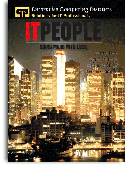IT Web Services – Table of Content
A Roadmap for the Enterprise
First edition; 355 pages
ISBN: 0-13-009719-5
( by: Alex Nghiem )
Table of Content
1. Business Drivers for Integration
Current Technological Limitations. Object-Oriented Technology. Component-Based Development (CBD). Middleware. Application Servers. HTML. Electronic Data Interchange (EDI). Packaged Applications. Enterprise Application Integration (EAI). Summary.
2. The Basic Web Services Stack.
Service-Oriented Architecture (SOA). Extensible Markup Language (XML). XML Syntax. XML Parsers. Service-Oriented Access Protocol (SOAP). Web Services Definition Language (WSDL). WSDL Syntax. Invoking Existing Web Services: A Sample. Universal Description, Discovery, and Integration (UDDI). UDDI Categories. UDDI Data Model. UDDI Usage Scenarios. Types of UDDI Registries. Web Services and Other Technologies. Phases of Adoption. Phase I (2002ö2003+). Phase II (2003ö2005). Phase III (2006+). Summary.
3. Enterprise-Level Web Services.
RPC-Oriented Web Services (Synchronous). Document-Oriented Web Services (Asynchronous). Loose Coupling. Asynchrony Support. A Business-Level Interface. The Importance of Messaging. Guaranteed Delivery. Only-Once Delivery. In-Order Delivery. Transformation. Content-Based Routing. Workflow Modeling. Adapters. Message Warehousing. Management. Models of Integration. Point-to-Point Integration. Publish-Subscribe Integration. Summary.
4. Web Services Platforms.
The J2EE Platform. The J2EE APIs. Java XML Pack. J2EE Web Services Integration. Major J2EE Vendors. BEA Systems. Iona Technologies. The Microsoft .NET Platform. .NET’s Main Component Areas. Visual Studio.NET. Business Impact of .NET. Summary.
5. Deployment Issues.
Web Services Security. Authentication. Encryption. Authorization. XML and SOAP Security. Web Services Scalability. Web Services over HTTP. Summary.
6. Web Services Networks.
Grand Central. Overview. Value-Added Features. Grand Central Summary. Flamenco Networks. Overview. Additional Functionality. Migrating to Flamenco Networks. Factors for Selection. Interview: Flamenco Networks. Interview: Grand Central Communications. Summary.
7. Web Services Architectural Patterns.
Native Web Services. Web Services Proxy. Document-centric Web Services. Orchestration Web Services. Summary.
8. A Plan for Adopting Web Services.
Identify Goals. Select the Pilot Project. Learn the Standards. Address Gaps in the Standards. Re-Evaluate the Development Process. Organize the Workflow. Use Existing Infrastructure. Skills. Hardware. Software. Publish the Web Services. Manage the Web Services. Pick the Tools and Vendor. Build the Budget and Schedule. Summary.
9. Emerging Trend: Software as a Service.
Value Proposition. Revenue Models. Interview: Employease, an SAAS Pioneer. Summary.
Appendix A. ebXML and Other XML Initiatives.
ebXML. ebXML Basics. Sample ebXML Integration Scenario. ebXML and Web Services. WSFL and Other Emerging Technologies. Interoperability Groups. Web Services Interoperability Group (WS-I). SOAPBuilders Group. The Liberty Alliance Project. Summary.
Appendix B. Case Studies.
Lessons Learned from Case Studies. Case Study: Reducing Integration Costs. (Putnam Lovell Securities Incorporated). Case Study: Building a Marketplace with Web Services. (Pantechnik International). Case Study: Building Private UDDI Repositories. (Talaris Corporation).
Appendix C. Perspectives of Web Services Vendors.
Interview: SilverStream Software, an Early Adopter of WSFL. Interview: Collaxa and Web Services Orchestration. Interview: Iona Technologies, an Interoperability Veteran. Interview: Cape Clear-Simplifying Development.
Appendix D. Product Review: XMLBus.
Overview. XMLBus Tools. Web Service Builder. Web Service Manager. Test Client. Message Spy. UDDI Browser. The XAR File. Publishing a Web Service. Deploying a Web Service. Conclusion.
Index.

















